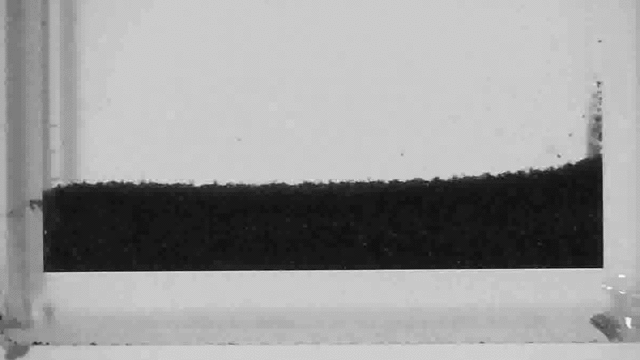
We intuitively understand that the sand pouring through an hourglass, for example, forms a neat roughly pyramid-shaped pile at the bottom, in which the grains near the surface flow over an underlying base of stationary particles. Avalanches and sand dunes exhibit similar dynamics. But scientists at Lehigh University in Pennsylvania have discovered that applying a magnetic torque can actually cause sand-like particles to collectively flow uphill in seeming defiance of gravity, according to a September paper published in the journal Nature Communications.
Sand is pretty fascinating stuff from a physics standpoint. It's an example of a granular material, since it acts both like a liquid and a solid. Dry sand collected in a bucket pours like a fluid, yet it can support the weight of a rock placed on top of it, like a solid, even though the rock is technically denser than the sand. So sand defies all those tidy equations describing various phases of matter, and the transition from flowing "liquid" to a rigid "solid" happens quite rapidly. It's as if the grains act as individuals in the fluid form, but are capable of suddenly banding together when solidarity is needed, achieving a weird kind of "strength in numbers" effect.
Nor can physicists precisely predict an avalanche. That's partly because of the sheer number of grains of sand in even a small pile, each of which will interact with several of its immediate neighboring grains simultaneously—and those neighbors shift from one moment to the next. Not even a supercomputer can track the movements of individual grains over time, so the physics of flow in granular media remains a vital area of research.
But grains of sand that collectively flow uphill? That is simply bizarre behavior. Lehigh University engineer James Gilchrist manages the Laboratory for Particle Mixing and Self-Organization and stumbled upon this odd phenomenon while experimenting with "micro-rollers": polymer particles coated in iron oxide (a process called micro-encapsulation). He was rotating a magnet under a vial of micro-rollers one day and noticed they started to pile uphill. Naturally he and his colleagues had to investigate further.
For their experiments, Gilchrist et al. attached neodymium magnets to a motorized wheel at 90-degree intervals, alternating the outward facing poles. The apparatus also included a sample holder and a USB microscope in a fixed position. The micro-rollers were prepared by suspending them in a glass vial containing ethanol and using a magnet to separate them from dust or any uncoated particles. Once the micro-rollers were clean, they were dried, suspended in fresh ethanol, and loaded onto the sample holder. A vibrating motor agitated the samples to produce flattened granular beds, and the motorized wheel was set in motion to apply magnetic torque. A gaussmeter measured the magnetic field strength relative to orientation.
The results: each micro-roller began to rotate in response to the magnetic torque, creating pairs that briefly formed and then split, and increasing the magnetic force increased the particle cohesion. This in turn gave the micro-rollers more traction and enabled them to move more quickly, working in concert to counterintuitively flow uphill. In the absence of that magnetic torque, the miro-rollers flowed downhill normally. The torque-induced action was so unexpected that the researchers coined a new term to describe it: a "negative angle of repose" caused by a negative coefficient of friction.
“Up until now, no one would have used these terms,” said Gilchrist. “They didn’t exist. But to understand how these grains are flowing uphill, we calculated what the stresses are that cause them to move in that direction. If you have a negative angle of repose, then you must have cohesion to give a negative coefficient of friction. These granular flow equations were never derived to consider these things, but after calculating it, what came out is an apparent coefficient of friction that is negative.”
It's an intriguing proof of principle that could one day lead to new ways to control how substances mix or separate, as well as potential swarming microrobotics applications. The scientists have already started building tiny staircases with laser cutters and videotaping the micro-rollers climbing up and down the other. One micro-roller can't overcome the height of each step, but many working collectively can do so, per Gilchrist.
DOI: Nature Communications, 2023. 10.1038/s41467-023-41327-1 (About DOIs).
Listing image by Lehigh University
"flow" - Google News
December 26, 2023 at 09:00PM
https://ift.tt/2DWf53y
Watch sand defy gravity and flow uphill thanks to “negative friction” - Ars Technica
"flow" - Google News
https://ift.tt/vOy3KaL
https://ift.tt/6EuRQCq
Bagikan Berita Ini














0 Response to "Watch sand defy gravity and flow uphill thanks to “negative friction” - Ars Technica"
Post a Comment